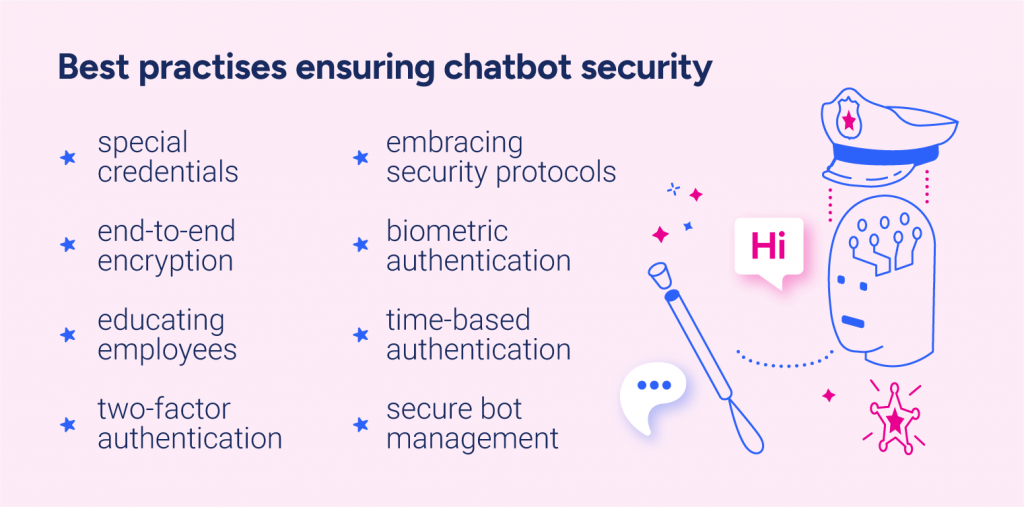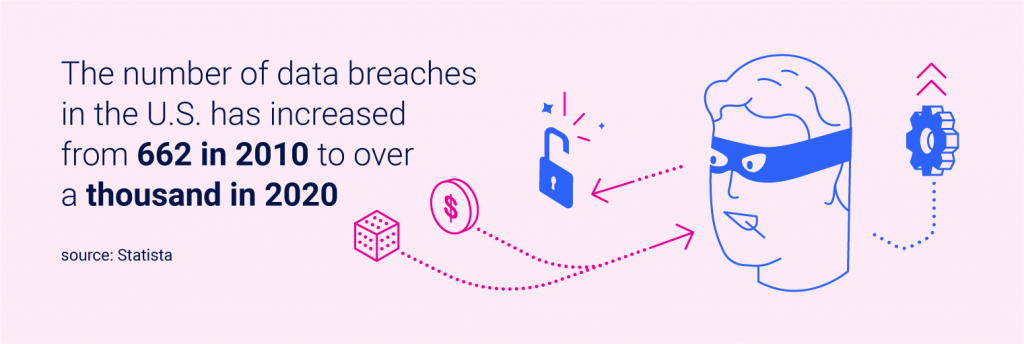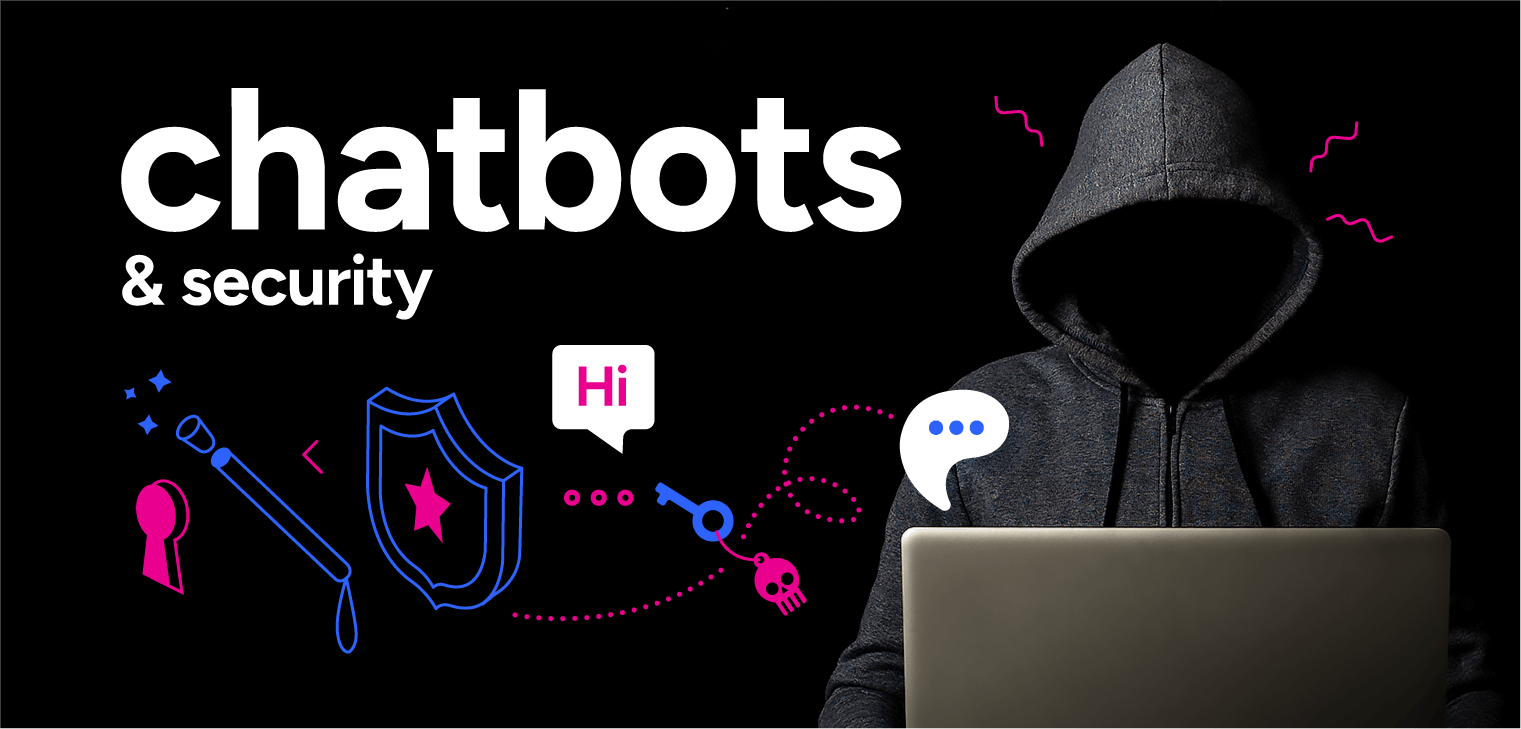Best practices ensuring chatbot security in your company
Chatbots are becoming ubiquitous in our lives. Many of us interact with them daily via the website, mobile applications, and other channels, especially for gaining customer support. Their value and benefits are evident with more intelligent chatbots that use natural language processing and machine learning to automate various processes. However, there is one thing that companies need to focus on – chatbot security. Let’s see some of the chatbot security issues and best practices that help to deal with them.
Introduction to the chatbot security
Chatbot security should be one of the crucial parts of their implementation because it is used to transfer sensitive data, both personal and financial. If designed securely, chatbots can really be beneficial for customers. In the finance industry, AI solutions automate various processes or answer individual questions, e.g. blocking credit cards, transferring money, or showing account statements. In other branches, chatbots are also using more sensitive data to provide the best customer care possible.

With chatbots turning into the trend, it is vital to implement chatbot security measures. There are many important measures companies can take to ensure the security of chatbots in their organizations. What’s more, well-skilled intelligent chatbots can also be a powerful tool to improve a company’s security posture, processes and readiness. Companies need to be sure they work with solution providers and integrators who understand chatbot security requirements and opportunities.
Types of chatbot security issues
Nowadays, AI technology is becoming truly strong. AI-based systems can replicate human speech and ensure effective communication with customers. Because of this, malicious chatbots are tough to find.
The most escalating chatbot security threat is that hackers can exploit them. Cyber attackers use chatbots to rob sensitive, personal data and trick customers to follow malicious links. Such malicious bots look normal, but their primary purpose is to gain corporate and personal information.

Internet users secure themselves from malicious bots only by filtering their network traffic for any malicious activities. Certain products like a cloud-based security suite, a DNS firewall, or a network security appliance automatically block the IP addresses and infected links that users might click.
However, apart from malicious bots, there are two significant security issues that chatbots face. The first one is the vulnerabilities that are the methods that a system is compromised. They cannot be identified and solved correctly on time. Chatbots are vulnerable especially because of human errors, sparse coding, and improper security. The most effective way to solve possible vulnerabilities is to implement Security Development Lifecycle activities into the development methods.
The second security issue, that chatbots come across, is threats. They are different methods by which a system is hacked, such as information disclosure, denial of service, repudiation, spoofing, and others.
How to ensure chatbot security?
Making sure that basic security principles are implemented is a must. Such practices include network security protocols, self-destructing messages, identity and access management, or end-to-end encryption. By complying with the security standards, enhancing chatbot security becomes much more efficient. And here are a few of the best practices.

Create special credentials for the chatbots
Making separate accounts for the bot with a similar access level in all applications instead of utilizing existing clients’ credentials is a smart practice. Separate accounts should sign into and utilize just selected accounts in the automated business processes. The main benefit is that it safeguards employees’ credentials.
Another good practice is to isolate the customers’ activities from the chatbot’s activities to ensure better examination and transparency. This will help establish an efficient security system for chatbots and take care of companies’ sensitive information.
End-to-end encryption
End-to-end encryption enables secure communication by encoding messages or information that is moving through the channel. Only the sender and the receiver can use the data, and no one else can view the sent information.
Regardless of whether hackers can gain access to servers where the information is stored, they can’t extract the data. They would need access to the decoding keys to understand the information. Chatbots should look up to the social media platforms in case of security issues. They have incorporated their messaging channels with end-to-end encryption to protect themselves from digital assaults.

Utilize two-factor authentication
Two-factor authentication is another technique to guarantee chatbot security. It includes requiring users that want to access the chatbot to confirm their identity through two separate channels. Verification codes are usually sent to the specified email or mobile number.
When the code is correctly entered, the user is approved and can access the bot. This may appear to be orthodox; however, it makes an exceptionally viable type of assurance. Two-factor verification is utilized by numerous companies, including financial and banking, where security is a basic necessity.
Biometric authentication
Biometric verification includes biological contributions to approve one user. Users can check their identity by applying remarkable biometric validation devices, like unique fingerprint scanners. The increased popularity of such innovation shouldn’t be surprising because it mostly guarantees security in personal devices. One of such devices – Iris, can scan unique fingerprints and becomes progressively popular.

Time-based authentication
Time-based authentication can guarantee better levels of security. Such practice provides access to the verified tokens only for a specific amount of time. When the token lapses, access is denied automatically. Sometimes users are inquired as to whether they are active before ending sessions. A counter can prevent a hacker’s repetitive attempts to figure their way into a secure account.
Educate the employees about the security
An increasing number of users understands the significance of digital security, but people are still the most fragile part of the chain. Chatbot security will keep on being an issue until the issue of human error stops existing. This will require careful education on how digital technologies can be developed securely.
Chatbot development techniques should incorporate developers, and IT specialists focused on educating employees. It enhances teams’ range of abilities and gives them the certainty to safely engage with the chatbot system.
Embrace security protocols
IT security groups should guarantee that the data within the company is being moved over HTTP, ensured by Transport Layer Security (TLS) or Secure Sockets Layer (SSL). Such practice restricts any potential indirect access to the company’s system.
They collaborate across platforms that have their internal security systems. There is more than one level of encryption to ensure users’ security. These security principles use cryptography and encryption. The information must be decrypted using a particular algorithm, a numerical equation, a logical key, or a combination.

Secure bot management
Safe bot administration plays a vital role in increasing security. The management platform needs to administer the capacity to control integrant access to users, support bot developments, delegate users to assigned bots, etc.
A central dashboard is essential for centralized observation and control. Chatbot activities must be recorded in different log files, so the IT team could compose custom logs to add additional traceability to the chatbot’s actions. Custom logging additionally can assist with designing better readable log files for business users to see.
Ensure your chatbot security today
With the development of new technologies, there are always security concerns. Companies should always think about new threats and vulnerabilities that may occur. Chatbots are an evolving technology, but the security practices that stand behind them are present for a long time and are effective. Chatbots will transform the way companies interact with customers. The point is to do everything we can to ensure chatbot security.


